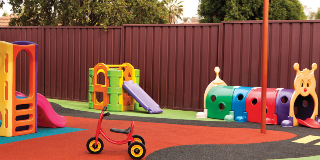Early learning and childcare workers compensation insurance
New South Wales
Information for workers
Whether you're navigating the process of getting back to work, or looking for answers to common questions, you'll find the resources and support you need right here.
Helpful guidance for workers

What to do if you have a work injury
- Report the injury immediately to your supervisor and seek medical treatment
- Lodge with your employer a Claim form, along with a medical certificate
After you lodge a claim
A case manager will contact you and explain the process of determining liability of the claim.
The claim may cover costs due to your injury including time lost from work, medical expenses, or other associated claim costs.
Further assistance and information
To contact us call: 1800 810 213
State Insurance Regulatory Agency (SIRA): 13 74 72
Complaints and dispute resolution
Complaints and dispute resolution is a process that helps customers resolve issues they have with our products or services. This process is designed to be fair, quick, and easy for customers to use.
FAQs for early learning workers NSW
Everyone who believes that they are a worker who injures themselves in the course of employment has the right to make a claim. Your Case Manager at Guild Insurance will speak to all stakeholders and take into account the information they provide before making a liability decision.
A ‘Worker’ is generally someone employed under a contract of service, whether written, oral, or implied, or who works under a contract at piecework rates primarily for labour. If you are unsure please check with your employer's Guild Insurance Account Manager or review the regulator website for your state/territory.
You must provide your Guild Insurance Claim Advisor with an up to date medical certificate. Payments will still come from your employer and Guild will then reimburse them.
A Return to Work Plan is a written plan that outlines how an employer will help an injured worker get back to work safely. It includes a list of support tasks by the Employer and Worker, a timeline to work toward, and any further requirements. See our return to work documents above (or in the Employer section for workers’ compensation of your state).
The doctor chosen by the Worker to oversee their injury management and treatment.
A Certificate of Currency confirms that your policy is active, it is also sometimes referred to as ‘proof of insurance’.
Not just an insurance policy
Risk articles with RiskHQ

You can visit RiskHQ at any time to read up about the unique risks you face as a business. We cover a variety of risk management topics, from managing complaints, to social media risks, maintaining your business and protecting your workers.
Early learning playground maintenance
There is a lot more to an early learning centre playground than just fun and games. They provide a great deal of benefit to children in developing their physical skills as well as their confidence and imagination. However, like many areas of an early learning centre, they unfortunately don’t come without risk.
The Education and Care Services National Law requires early learning centres to protect children from harm and any hazard. Therefore, it’s recommended that any products purchased, including both equipment the children play on and other materials around the playground such as softfall, meet relevant Australian Standards.
Another way to manage the risk of a playground and increase its lifespan is for centres to put a maintenance program in place. A maintenance program will provide centre staff with information regarding what equipment is to be inspected, how often, what is being looked for during these inspections and what to do if there are any problems. This structured approach will create consistency between staff members and make it more likely the inspections will be done as and when they should.
What is a maintenance program?
All centres should create a maintenance program for that individual centre. There is no one exact way this should be done as it will vary according to a range of factors such as the type of equipment in the centre, the age of the equipment and the climate of that location.
Daily checks of playground equipment should be occurring in every early learning centre. This is required to be sure no damage has occurred with the regular and frequent use of it. However, it’s also worth undertaking a more thorough and detailed inspection less frequently. This might occur every three to six months or more frequently if required. Centres should also undertake inspections when significant events, such as storms or vandalism, have occurred as they may cause damage to equipment.
When undertaking any inspection and maintenance program always:
- Follow the manufacturer instructions for any repair, service and cleaning.
- Keep a record of the inspections undertaken and any repairs needed and then carried out.
- Carry out additional unscheduled checks following any significant event, such as a storm or vandalism, which may have caused damage to playground equipment.
Help is available…
There are a range of organisations available to assist with playground safety. To be sure your playground has been installed and is being maintained in the safest and most appropriate manner, consider engaging experts. Installers of playground equipment will often provide maintenance programs. There is also range of organisations, both private and government, in all states and territories who offer playground safety information as well as inspections.
Download PDF here.
- Childcare
- Early Learning
- Business
- Professional








Write a review Average rating: